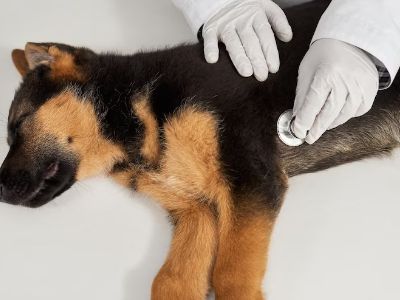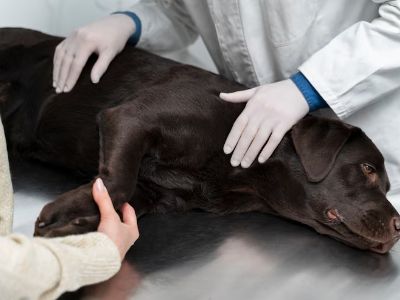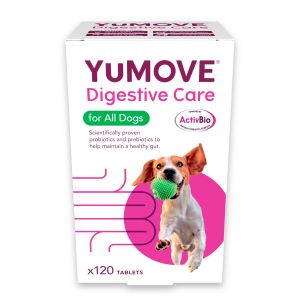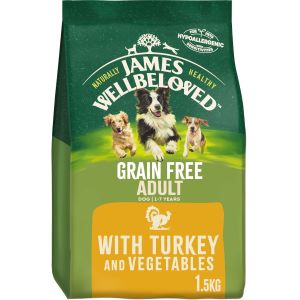In my years of professional experience as a vet, I have seen dogs suffer from different health issues. But, the one which makes a vet shake, is Bloat. Every vet hates this disease and while they are treating bloat in dogs the survival chances of the dog are often less.
Having seen other dogs suffer this life-threatening disease I hope your furry friend doesn’t face this health issue. So, if your furry friend hasn’t got this disease and you are looking to get details about what is bloat in dogs, what are the signs of bloat in dogs or the preventive measures, keep reading!
You Might Also Like:
Bloat In Dogs
Bloat which is also referred to as GDV i.e. gastric dilation-volvulus, is a medical and surgical emergency. This condition arises when your furry friend’s tummy is full of food, gas, or fluids and it expands. The twisting and expanding often cut off the blood supply to the gut and prevents gas from leaving.
Further, it can also block crucial veins in the back of your furry friend which often directs the blood towards the heart. In addition, the expansion puts excessive pressure on the other organ and it can lead to other health issues. Your dog may have:
- Difficulty breathing
- Tear in the wall of their stomach
Symptoms of bloat in dogs
Bloat in dogs is very quick. Your furry friend will show signs of stomach ache and you will observe these signs while they are in pain:
- Will act restless
- Have a swollen belly
- Drooling
- Feel pain in the abdomen region
- Anxious
- Not able to vomit even after countless efforts
Further, when their health worsens you will see them collapse, have pale gums, high heart rate, get weaker, and have difficulty in breathing. So, if you observe these symptoms and feel that your dog has bloat, you must straightaway take them to the nearest clinic.
What Causes Bloat In Dogs?

In general, vets are not entirely sure about the cause of bloat in dogs or why some dogs are prone to this disease. However, over the years, the vet community has identified certain risk factors that potentially lead to bloating. Here are some risk factors:
- Eating fast – if your dog is habitual of quickly finishing their meal they may develop the condition.
- Eating from the elevated bowl – if your dog’s eating bowl is elevated, they are at higher risk of developing bloating. This is mainly because eating from such a bowl may cause dogs to consume more air along with the food and this often results in gas accumulation in the stomach.
- Heavy meal – dogs eating a heavy meal can have bloating issues because the large quantity of food often leads to gastric issues. The large meal gets accumulated in the stomach and improper digestion will cause bloating.
- Exercising or playing after meals – if your furry friend immediately engages in exercise, playing or any intense physical activity they are likely to suffer from bloating. The movement causes twisting of the food items within and it’s not good. To avoid bloating because of any physical activity, it’s my recommendation you at least wait an hour before you allow your dog to play or exercise.
Swelling in the belly of a dog
The swelling in the belly region does indicate a possible bloating issue but, there are many other conditions which cause the swelling and make the belly look bloated. So, before moving forward with any treatment a vet will identify the actual cause because it’s possible that it’s a different condition.
#1 Cushing’s syndrome
This condition is a result of the excessive release of the stress hormone cortisol. A dog suffering from this condition may have a tumour on one of the adrenal glands. In addition, long-term usage of steroids can also cause this syndrome. You will observe the following signs if your dog is having this syndrome:
- Excessive drinking of water
- Eating food continuously
- Panting is increased
- Hair loss
The treatment for this condition will involve medications which help to suppress the production of cortisol hormone. In addition, the vet may also suggest a surgical procedure if they find any tumour.
#2 Peritonitis
Peritonitis is a condition where there is a rupture or a puncture in a dog’s stomach or intestine. The major cause of this problem is the ingestion of bones. Dogs with ulcers or tumours will also suffer from this condition.
In addition, a rupture in the urinary bladder or gallbladder can also make a dog suffer from peritonitis. The dog will exhibit the following signs or symptoms while having this condition:
- Vomit frequently
- Swelling near belly
- Not willing to move
- Limping
The dog is also likely to suffer from a septic shock in the abdomen, inflammation and accumulation of fluids because of the ulcers or tumours. The treatment for peritonitis will include antibiotics, pain relief, intravenous fluids i.e. IV fluids, or surgery. The surgery will be required to fix the rupture or remove the infected fluid or the abdomen.
#3 Ascites
A dog suffering from ascites has their abdomen full of fluids. Failure of organs such as kidneys, heart, or trauma or tumours are prominent causes of ascites. You will notice the following symptoms in a dog suffering from this condition:
- Abdominal swelling
- Difficulty in breathing
- Vomiting
- Lack of appetite
The treatment for this condition will depend on the cause. Normally, the treatment course chosen will aim for reducing fluid retention and inflammation. In addition, there is fluid therapy, dietary modifications, or surgical options available for dealing with this condition.
Additional reasons for swelling in the belly
The underlying causes for swelling in the belly region are not limited to these 3 conditions. There are many other issues which can lead to the swelling. Here are some additional reasons why your dog may have swelling near their belly region:
- Uterine infection: referred to as pyometra, is a condition where the female canines face bacterial infection in the uterus. The pus accumulated and inflammation causes swelling near the belly and abdomen region.
- Constipation: a common yet troublesome issue. Dogs who have difficulty passing their stool will have a firm and swollen belly.
- Pregnancy: female dogs may have swelling on their belly during this time and it’s quite normal.
- Intestinal issues: the problems caused in the digestive tract, for instance, inflammatory bowel movements, infections, parasites, or severe issues like cancer can lead to fluid accumulation, and cause swelling near the belly area.
Treatment For Dogs Suffering From Bloating
The cause for determining bloat/GDV is tough but, being a vet I can assure you that we can tell whether or not the dog is suffering from it. A dog’s distressful behaviour and physical appearance easily indicate the issue but, there is a need for a thorough diagnosis to verify the disease.

So, before proceeding with the treatment, here are some of the tests the vet may conduct to verify the bloating diagnosis.
- Blood test – for analysing and getting insights into a dog’s health.
- Abdominal X-rays – the x-rays will confirm the diagnosis and help in determining how serious the bloating issue is. An x-ray will show whether or not the bloat has progressed to the level of GDV or not. This helps in deciding the treatment course.
Treatment
The treatment for bloat involves using intravenous fluids once the dog’s diagnosis is confirmed. If the bloating is because of the gas accumulated in large amounts, they are walked frequently to facilitate the release of the gas and lessen the pressure.
- The vet will insert a tube down your dog’s throat for releasing the pressure that is building up inside their stomach. At times, the stomach of the dog is twisted and the tube cannot pass through, in such cases, a vet will use a needle and pass it through the belly for releasing the pressure.
- Intravenous fluids with electrolytes are used for treating shock and oxygen therapy is for improving circulation to different organs. In addition, pain medications or antibiotics are also used for dealing with distress, shock or restoring dead tissues.
If bloating is not severe the above-mentioned methods often help dogs recover from it but, at times, surgery is the only choice a vet has.
- In surgery, a vet will untwist the stomach and may also remove a particular section of it. This happens because the region is dead as there was minimal blood circulation.
- The stomach will be stitched to the body part for preventing it from twisting again. This procedure is gastropexy.
Post-surgery, there is continuous monitoring of their health condition, especially the heart. The staff will continuously monitor it for ensuring there are no anomalies. However, the survival chances for a severe bloating condition are much less and some dogs don’t make it even after the surgical procedure.
But, the misconception of the condition not being treatable is inaccurate. Yes, the treatment is costly and the surgical procedure can get more expensive, but, the situation is a lot better than it was two decades ago. The clinics and hospitals now have modern equipment set up for treating such severe conditions.
How To Prevent Bloat In Dogs
The condition is severe and it becomes crucial to try and contain it before it elevates. Taking your furry friend for regular checkups will help in keeping a close watch on their vitals. So, if a vet finds some anomaly, they can easily act on it (in this case – bloating).
At home, you must keep an eye on your dog’s health, especially the region around the belly. For any indication of swelling, you should visit the vet. These were some basic aspects that can help in dealing with the bloating issue in the early stages. Now, let’s see how you can prevent it.
- Diet control
We saw that excessive eating can cause bloating in dogs. So, you must feed their regular diet in small portions. This means, instead of serving them a large meal, split it into two or three meals per day. This will help in managing their digestion.
A controlled diet will ensure your dog doesn’t overeat. This prevents gas accumulation in the stomach and reduces the chances of your furry friend getting bloating.
- Reduce the pace of eating
Dogs who are habitual of eating at a quick pace are susceptible to bloat disease. The quick pace of ingesting different food items will accumulate air in the stomach and cause bloating issues. So, it becomes crucial to manage the pace at which your dog eats.
You can slow down the pace using different food puzzles or slow-feeding bowls. Once you use this trick, you will see a significant reduction in the pace at which your furry friend eats their meal.
- No exercise before or after a meal
Exercising for dogs is good but, not much if they do it moments before having their daily meal or immediately after. Because if your furry friend walks or exercises before or after having their meal, there is a high possibility of their stomach getting twisted.
Hence, make sure that you maintain at least a gap of an hour between their exercise and meal. This simple adjustment can help prevent the bloating issue.
- Avoid serving food with oil or fat
If your dog is eating food which retains high fat or oil content, it will have some serious digestive issues. Both of these ingredients make digestion slow and your furry friend’s tummy will get full of gas. The gas accumulation will lead to bloating so, it’s better to feed them food which has less oil and fat distribution.
- Don’t use a highly raised bowl
When you are using a highly raised bowl for feeding your dog, they intake more air while eating. The pressure in the stomach elevates because of the air inside. This leads to bloating issues and so, it’s best to use bowls which are not that heightened.
There are bloat bowls available in the market which are precisely designed keeping the height aspect in mind. In addition, these bowls have different partitions that help in controlling the pace of eating.
- The dog must not drink too much water
If your furry friend drinks lots of water at once, it can lead to water intoxication and the excessive amount of water puts pressure on the surrounding organs. This pressure can lead to bloating issues in the dog.
In addition, too much water can also cause electrolyte imbalance and this is also one of the reasons why dogs suffer from bloating issues. The imbalance can also cause other issues such as vomiting, weakness etc.
Following these suggestions will help you prevent the bloating issue in your furry friend. If your dog breed is prone to stomach issues, the vet may have prescribed some medications. Use them as per the instructions and your dog will not face any severe issues.
You are probably wondering which dog breeds are likely to suffer from bloating. Let’s have a look at the list:
- Greyhound
- Poodle
- Basset Hound
- Cocker spaniel
- Great Dane
- Saint Bernard
- Weimaraner
- Akita
- Boxer
- Doberman Pinscher
- German Shepherd
- Setter breeds
FAQs
Can dog bloat resolve itself?
No, bloat n dogs won’t resolve themselves. It is a life-threatening emergency and demands rapid intervention from the vet. It is fatal and the majority of the time surgical procedure is necessary. So, if you notice signs indicating bloating in your dog, you must immediately take them to a vet for treatment.
Is puppy bloat normal?
Yes, puppy bloat is normal but, there is no way to tell what exactly causes bloating in puppies. However, there are some factors like – eating too much food or water, eating quickly, or exercising just before ingesting food or after taking the meal which contributes to puppy bloat.
Why dog has swollen stomach but no pain?
Dog swollen stomach with no pain can point to several aspects. One of the common aspects is overeating. Overeating may cause digestive issues and the accumulation of gas inside often leads to swelling. Another aspect is – their natural instinct to hide the pain. Yes, dogs hide their pain and this is why you may see them indicate no pain while having a swollen stomach.
Can a dog poop with a bloated stomach?
No, a dog with a bloated stomach cannot poop. Stomach torsion blocks the path and exits to the stomach and nothing can enter in or go out. The dog-bloated stomach also stops the excretion of toxic waste in the body. They may have diarrhoea but no hard stool is passed while their stomach is bloated.
Dog swollen belly drinking lots of water, why?
A dog having swollen belly and drinking lots of water may have ample reasons. But, in general, the issue is bloating. The dog whose belly is swollen drinks excessive water to help with the release of the gas which is inside. But, at times, excessive drinking of water is the cause of a swollen belly so, you must consult your vet to solve the issue.
Bloat In Dogs – Author’s remark
A bloated stomach is a serious issue in dogs and because it’s life-threatening, you must not ignore any signs of bloat in dogs. Otherwise, the damage done to the stomach and other organs is severe and the dog may even die. The stomach of your furry friend is filled up with gas and if it gets twisted, the blood circulation also stops.
In addition, if you have a breed that is prone to this disease you can consult your vet and use some preventive measures for avoiding this issue. The general risk factors pertaining to bloated stomachs in dogs are eating habits, exercise, and food. So you have to make sure your dog is having a healthy diet and doesn’t have bad eating habits.
The earliest you identify the symptoms, the better for your dog. Because if the diagnosis is done late, your furry friend may not survive.






